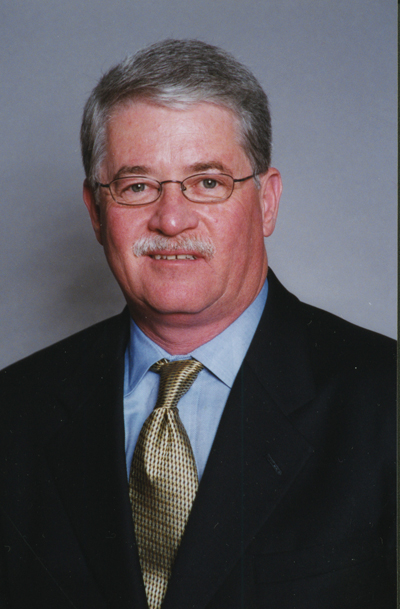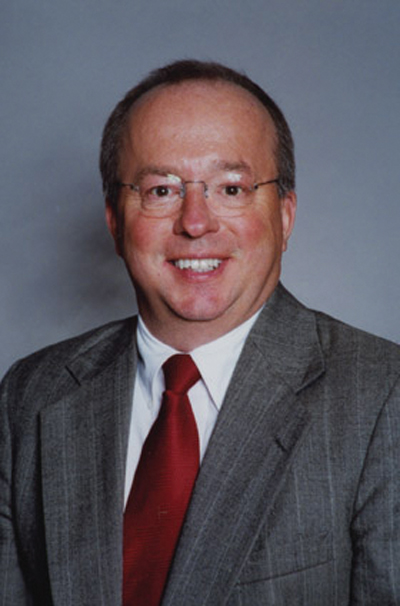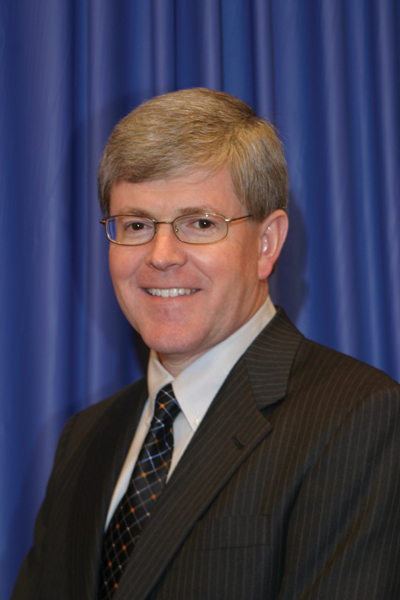As the scope of optometric practice continues to expand, optometrists will continue to confront many challenges. Optometrists C. Thomas Crooks, III, president-elect of the American Optometric Association (AOA); Richard L. Wallingford Jr., AOA president; and Kevin L. Alexander, AOA vice president, discuss the changes and challenges optometry faces and how the AOA plans to address them.
 |
C. Thomas Crooks, III, O.D.,
President-Elect |
Q: How do you plan to help optometrists continue to improve the quality of care they provide to patients?
A: We will continue to focus on children, and well work to meet the needs of the baby boomer generation. Some of our efforts include expanding the InfantSEE program and advocating mandatory eye exams for children. We will also continue to help all Americans have greater access to O.D.s.
Q: The care optometrists provide has evolved in many states in recent years. How can patients benefit by having optometrists provide additional services, and what makes optometrists qualified to move into new areas of eye and vision care?
A: Patients have fewer office visits to eye care practitioners and less travel time when optometrists provide more services. Optometrists are qualified to move into new areas of eye and vision care because they are continually exposed to improved technology and are taking advantage of continuing education and training. In turn, optometrists scope of practice has increased, allowing them to provide more services and treatments to patients.
Q: What are the AOAs advocacy goals for the coming year?
A: The AOA continues to advocate for the profession at the federal and state levels on a wide variety of issues. These include matching optometrists scope-of-practice rights to their expanding education and training as well as preventing and stopping discriminatory practices that attempt to interfere with patients access to optometric services.
Q: Grassroots political activity has been the strength and backbone of organized optometry. What is the AOA doing to foster a new generation of legislative grassroots leaders?
A: Involvement in the political and legislative process is one of the most important contributions of AOA members to the profession. This fall, we will host a meeting to identify the next generation of optometrists and train them to keep the grassroots system as an important part of their everyday political activities.
Q: What is the AOA doing to strengthen optometrys voice on Capitol Hill?
A: The AOA has more than 700 optometrists who participate in the federal grassroots effort. Also, our Washington office constantly monitors federal legislation and regulations and lobbies on behalf of optometry at the nations capital. We also plan to double our efforts through our political action committees activities to support political candidates who are friends of optometry.
Q: What legislative initiatives are taking place at the state level?
A: First, we are working to expand the scope of optometry in states that might not have all the scope-of-practice rights that they desire. For example, Massachusetts is working to obtain oral drug and glaucoma treatment authority, and Alaska and New York are working to obtain oral drug treatment authority. Very few states remain in which optometrists are not properly legally recognized for their professional education and training, but we are always looking to improve state laws for the sake of our patients.
Second, we are working to prevent legislation proposed by 1-800 Contacts to alter the distribution channels of lens manufacturers. This is ongoing in several states because the issue involves optometrists who write prescriptions for lenses sold only to eye care practitioners.
Q: 1-800 Contacts is waging a state legislative campaign ostensibly against the distribution of private label doctor only lenses. What is the AOAs stance on this legislation?
A: We oppose this form of legislation primarily because it potentially can interfere with a doctors ability to prescribe the best contact lenses for patients. The manufacturers, on the other hand, are opposing the legislation for reasons related to altering the course of business. The Federal Trade Commission (FTC) has also said that the legislation being proposed attempts to fix a problem that does not exist, and such legislation will harm consumers by raising the price of contact lenses. The FTC has issued a formal letter to 1-800 Contacts warning them of potential violations to the Fairness to Contact Lens Consumers Acta federal law protecting consumers regarding contact lenses. However, 1-800 Contacts has ignored the economic advice of the FTC.
The AOA has been providing states with extensive documentation of the problems with the legislation proposed by 1-800 Contacts. Our state government relations center constantly communicates with states to help them fight this proposal.
Q: Optometrists have been proposing licensure by endorsement. Does the AOA continue to support the adoption of this process by the states?
A: Absolutely, and we have done so for the past decade. This is a top priority of our state government relations center. The AOA has established criteria for what constitutes true licensure by endorsement for genuine ease of mobility for optometrists throughout the country. We communicate these criteria to the states to serve as their guide for effective legislation. Our state government relations center then provides states with political, technical and lobbying advice to help them pass the necessary laws to get the job done. Ultimately, it is up to the states to make this happen.
Licensure by endorsement has been somewhat slow to gain support at the state level. However, South Dakota and Wisconsin have signed full-fledged licensure by endorsement into law this year, so we are making progress and will continue to work on this issue.
Q: How much progress has been made toward enacting uniform TPA laws in each state?
A: Much progress has been made in little time. Today, all 50 states grant some therapeutic privileges to optometrists. Forty-nine states allow O.D.s to prescribe glaucoma drugs, and 45 states allow O.D.s to prescribe oral medications. In 2005, Mississippi became the most recent state to provide expansive oral drug authority to optometrists. Now, only five states lag behind in this area, so there is still some work left.
Q: Can you highlight some of the accomplishments of the InfantSEE program since its launch in June? What goals does the AOA have for the program?
A: First, more than 7,300 optometrists signed up to serve as providers for this program. InfantSEE has received more than 35 million media impressions including television appearances on the Today Show and Live with Regis and Kelly, and print coverage in USA Today and the parenting magazines American Baby and Baby Talk. An InfantSEE segment was also broadcast on the WebMD site (www.webmd.com). Also, more than 171,000 people have visited the InfantSEE Web site.
We definitively know that more than 8,200 infants have had their vision assessed, but we believe that number could be far greater. Were encouraging our participating doctors to return assessment forms, which are our only measure of how many infants have been seen. Our goal for 2006 is for 100,000 babies to undergo an eye assessment. Like any new program, this takes time, but the framework is in place. We believe the program has been very successful and will become more successful in time.
 |
Richard L. Wallingford Jr., O.D.,
President |
Q: The AOA played a large role in the recent ruling that grants the FDA the authority to regulate plano decorative contact lenses as medical devices. Why was this issue so important to optometry?
A: This legislation was more important for the patients who wear decorative lenses than for optometry. People wearing the lenses had no idea how contact lenses should fit on their eyes, and doctors were not able to follow them to check for irritation. Additionally, several cases of serious damage to eyes and loss of vision were documented. Improper care and handling of lenses led to such cases. Contact lenses are medical devices and need to be treated as such. Improper handling of any type of contact lenses can have devastating health consequences, as the recent outbreak of the sight-threatening fungus fusarium keratitis has demonstrated.
Q: Is the AOA currently involved in other legislative efforts that might similarly protect consumers?
A: Other legislative efforts that the AOA is currently opposing include Senate bill 1955 and a federal bill proposed by 1-800 Contacts. Senate bill 1955 allows small groups to buy health insurance. When this occurs, the health insurance will be regulated under the Employee Retirement Income Security Act (ERISA) instead of by state laws. This can affect optometry because the ERISA rules override state laws for non-discrimination and the ability to provide emergency eye care without prior authorization.
The federal bill introduced by 1-800 Contacts attempts to force all contact lens manufacturers to sell their lenses to 1-800 Contacts. This bill is anti-competitive and can raise prices for consumers.
Q: In 2004, the American Academy of Ophthalmology (AAO), through a formal resolution, decided to deny optometrists access to their annual meeting. What do you think about this, and will the AOA address this issue?
A: Denying optometrists access to lectures about patient care is selfish and unethical. Optometrists perform two-thirds of all eye exams in the United States, so a closed door seems against doing what is right for patients. The AOA has filed a complaint with the Federal Trade Commission claiming that the AAO and other groups, such as the American Society of Cataract and Refractive Surgery, are jointly denying optometrists access to their meetings to restrain our trade and growth.
 |
Kevin L. Alexander, O.D., Ph.D.,
Vice President |
Q: You have been conducting a series of summits to help determine the desired state of optometry in the year 2020 and beyond. What are the areas of focus in this process?
A: The series of summits is focusing on where optometry is going in the future. The first summit examined the global perspective, including megatrends, demographics, what the economy is going to look like in 2020, how business will be organized in 2020 and the future state of technology. In the second summit, attendees considered what they learned in the first summit and selected preferred futures in eight basic areas: eye-care patient/consumer; science and technology; economics; eye-care delivery; human resources; knowledge, education and training; licensure, regulation and continued competence; and industry and professional synergies.
In the third summit, to be held in August 2006, attendees will determine how the preferred futures of the eight areas they previously considered will fit into the strategic plans of major organizations within the profession. Finally, we will issue a report to the profession in which we discuss how to move optometry to the preferred future.
Q: Based on the knowledge and feedback gained at the first two summit meetings, how is the AOA preparing to provide patient care in 2020?
A: First, we will continue to embrace technology, which will affect how we diagnose and treat disease. Second, we are considering how patients will be different in 2020. For example, theyll be more diverse and better informed due to the Internet. In 2020, practitioners should be bilingual or be able to accommodate patients who speak Spanish.
The AOA will advocate initiativessuch as increased educational and training activities, increased public and community health programs, and expanded ongoing contact via the latest electronic technologies with optometry schools and colleges worldwideto ensure that optometrists can take advantage of future technology and medical advances.
Q: What types of challenges might optometry experience in 2020 and beyond?
A: Our biggest challenge will be patient access. Some patients will not have access to good optometric care because third-party or government plans force them to see certain types of practitioners. However, optometrists will not be content with a profession that is boxed in and defined by such artificial boundaries. The only boundary to providing a service should be our knowledge base and our ability to learn to provide a service.
Behind the Scenes at the AOA
Richard L. Wallingford, Jr., O.D., President
Dr. Wallingford began serving as president of the AOA Board of Trustees in June 2005. He currently serves as chair of the executive and building committees and as a member of the agenda committee. Dr. Wallingford also serves on the board of trustees of the New England College of Optometry.
C. Thomas Crooks, III, O.D., President-Elect
Dr. Crooks was elected to the AOA Board of Trustees in June 1999, re-elected in 2002, and elected to president-elect in June 2005. He also serves as chair of the personnel committee and as a member of the agenda, executive, and program planning committees. Dr. Crooks is currently president and CEO of EyeCare Associates, Inc., in Birmingham, Ala.
Kevin L. Alexander, O.D., Ph.D., Vice President
Dr. Alexander was elected to the AOA Board of Trustees in June 1999, and as vice president in June 2005. Dr. Alexander also serves as a member of the AOA constitution and bylaws, executive, personnel, and program-planning committees. He serves as speaker of the house pro tempore. He also is co-chair of Optometry 2020, a series of three summits examining what the profession of optometry will look like in 2020. Dr. Alexander currently practices at Personal Eyecare in Sylvania, Ohio, and is dean at the Michigan College of Optometry.
Wesley E. Pittman, O.D., Past President
Dr. Pittman assumed the office of the AOA past president in 2005. He was elected to the AOA Board of Trustees in 1996. Dr. Pittman is currently chair of the AOA agenda committee and member of the executive committee. He serves as the 2006 speaker of the house. Dr. Pittman currently serves on the Bricks and Mortor Board of Parkview Regional Hospital in Mexia, Texas, and is a consultant to the Mexia State School, a mental health and retardation facility.
Peter H. Kehoe, O.D., Secretary-Treasurer
Dr. Kehoe was elected to the AOA Board of Trustees in June 1999, re-elected in 2002, and elected as secretary-treasurer in June 2005. Dr. Kehoe also serves as chair of the constitution and bylaws and finance committees and is a member of the executive, program planning, and building committees. He was a member of the team that developed and launched InfantSEE. Dr. Kehoe is currently in private practice in Galesburg, Ill., and provides optometric services to the Illinois Department of Corrections.
Randolph Brooks, O.D.
Dr. Brooks was elected to the AOA Board of Trustees in June 2000 and re-elected in June 2003. He serves on the AOA finance and constitution and bylaws committees and as board liaison to the AOA advocacy group, AOA political action committee, Association of Regulatory Boards of Optometry, and Association of Schools and Colleges of Optometry. He is in private practice in Ledgewood, N.J.
J. Wayne Buck, O.D.
Dr. Buck was elected to the AOA Board of Trustees in 2002 and re-elected in 2004. He serves as liaison to the AOA communications group, paraoptometric section, commission on paraoptometric certification, Armed Forces Optometric Society, and National Optometric Association. Dr. Buck is in private practice in Crossett, Ark.
Dori Carlson, O.D.
Dr. Carlson was elected to the AOA Board of Trustees in June 2004. She serves as member of the personnel committee and is board liaison to the AOA information and member services group, contact lens and cornea section, and American Optometric Student Association. She is also on the InfantSEE Management Team and is liaison to the InfantSEE committee. Dr. Carlson currently is in private practice in Park River and Grafton, N.D.
David A. Cockrell, O.D.
Dr. Cockrell was elected to the AOA Board of Trustees in June 2005. He serves as liaison to the AOA clinical care group, sports vision section, College of Optometrists in Vision Development, Optical Laboratories Association, and Volunteer Optometric Services to Humanity. Dr. Cockrell currently practices in Stillwater, Okla.
Joe E. Ellis, O.D.
Dr. Ellis was elected to the AOA Board of Trustees in 2001 and re-elected in 2004. He is a member of the finance and building committees, and liaison to the AOA advocacy group and National Board of Examiners in Optometry. He is in private practice in Benton, Ky.
Ronald Hopping, O.D., M.P.H.
Dr. Hopping was elected to the AOA Board of Trustees in June 2005. He serves as liaison to the Accreditation Council on Optometric Education, AOA clinical care group, low vision rehabilitation section, Neurological Optometric Rehabilitation Association, and Optometric Extension Program. Dr. Hopping currently is in private practice in the Clear Lake area of Houston, Texas. |
Vol. No: 143:05Issue:
5/15/2006




